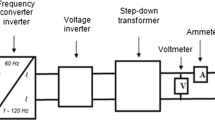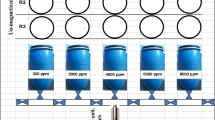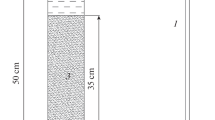Abstract
Competing demand for high-quality fresh water for agricultural, industrial, and municipal uses has placed tremendous stress on water resources; irrigating crops with fresh water is expensive and unsustainable. Using unconventional water sources such as oilfield produced water (PW) and treating PW with physical treatment methods such as electromagnetic treatment may overcome water-limitation challenges. A germination experiment was conducted using treated and untreated PW to examine the effect on the germination of iron and clay cowpeas (ICCs) since germination is the stage at which plants are most sensitive to external factors and stresses. The results from the study showed that ICCs germinated when irrigated with higher salinity water that was treated using the electromagnetic technology. A plant growth study was also conducted to assess the effect of electromagnetic treatment of high-salinity PW on the growing ability and crop health of ICCs. A reduction in leaf area expansion rate, the first indicator of salt stress on plants, was observed. After 14 days, plants showed early signs of salt stress such as wilting, lightening in color, and reduction in leaf area. After 28 days, plants watered with higher salinity PW (21,475–42,950 mg/L total dissolved solids) died and plants watered with lower salinity PW (< 21,475 mg/L total dissolved solids) survived but grew smaller than plants irrigated using fresh water. Results from both experiments suggested a potential total dissolved solids limit of ICCs or electromagnetic technology (or both) between 4000 and 10,000 mg/L. The results further suggested that while the electromagnetic technology did not have a strong effect on plant growth, high-salinity water might be treated for reuse in agriculture.











Similar content being viewed by others
References
Andrade BG, Andrade VT, Costa BRS, Campos JC, Dezotti M (2011) Distillation of oil field produced water for reuse on irrigation water: evaluation of pollutants removal and ecotoxicity. Journal of Water Reuse and Desalination 1(4):224–236
Araújo SDS, Paparella S, Dondi D, Bentivoglio A, Carbonera D and Balestrazzi A (2016) Physical methods for seed invigoration: advantages and challenges in seed technology. Front Plant Sci 7(646)
Ayers RS, Westcot DW (1985) Water quality for agriculture. Food and Agriculture Organization of the United Nations, Rome
Azadi H, Samiee A, Mahmoudi H, Jouzi Z, Khachak PR, De Maeyer P, Witlox F (2016) Genetically modified crops and small-scale farmers: main opportunities and challenges. Crit Rev Biotechnol 36(3):434–446
Benko KL, Drewes JE (2008) Produced water in the Western United States geographical distribution, occurrence, and composition. Environ Eng Sci 25(2):239–246
Burgos M and Lebas G (2015) Beneficial reuse of production water for irrigation, International petroleum technology conference
Burkhardt A, Gawde A, Cantrell CL, Baxter HL, Joyce BL, Stewart CN, Zheljazkov VD (2015) Effects of produced water on soil characteristics, plant biomass, and secondary metabolites. J Environ Qual 44(6):1938–1947
Champ MA (2015) Treating saline groundwater for improved crop irrigation. ACRES USA The Voice of Eco-Agriculture 45(10)
Champ MA (2016a) Sustaining resources in agriculture: low saline groundwater - a new water. Irrigation International Conference, Austin, Texas, Irrigation Today
Champ MA (2016b) Technology for treating saline groundwater: a new water resource for agriculture. Water Technology: 26–30
Clark CE and Veil JA (2009) Produced water volumes and management practices in the United States. United States Department of Energy, Environmental Science Division, Argonne National Laboratory: Argonne, IL
da Costa Marques MR, de Souza PSA, Rigo MM, Cerqueira AA, de Paiva JL, Merçon F, Perez DV (2015) Effects of untreated and treated oilfield-produced water on seed germination, seedling development, and biomass production of sunflower (Helianthus annuus L.). Environ Sci Pollut Res 22(20):15985–15993
De Souza A, Garcí D, Sueiro L, Gilart F, Porras E, Licea L (2006) Pre-sowing magnetic treatments of tomato seeds increase the growth and yield of plants. Bioelectromagnetics 27(4):247–257
Efthimiadou A, Katsenios N, Karkanis A, Papastylianou P, Triantafyllidis V, Travlos I, Bilalis DJ (2014) Effects of Presowing pulsed electromagnetic treatment of tomato seed on growth, yield, and lycopene content. Sci World J 2014:6
Fader M, Shi S, von Bloh W, Bondeau A, Cramer W (2016) Mediterranean irrigation under climate change: more efficient irrigation needed to compensate for increases in irrigation water requirements. Hydrol Earth Syst Sci 20(2):953–973
Fearon RE, Carlitz JM, Poola S, Champ MA, Smallwood J and Bobenrieth J (2015) Method and apparatus for conditioning fresh and saline water. U. S. P. a. T. Office, Transglobal H2o, LLC. (Houston, TX, US) 0151986 A1
Fipps G (1996) Irrigation water quality standards and salinity management strategies. Texas Agricultural Extension Service, Texas A&M University System
Flórez M, Carbonell MV, Martínez E (2007) Exposure of maize seeds to stationary magnetic fields: effects on germination and early growth. Environ Exp Bot 59(1):68–75
Gerard M, Noamen O, Evelyne G, Eric V, Gilles C, Marc H (2015) Hydraulic continuity and biological effects of low strength very low frequency electromagnetic waves: case of microbial biofilm growth in water treatment. Water Res 83:184–194
Glenn EP, Brown JJ, Blumwald E (1999) Salt tolerance and crop potential of halophytes. Crit Rev Plant Sci 18(2):227–255
Hachicha M, Kahlaoui B, Khamassi N, Misle E and Jouzdan O (2016) Effect of electromagnetic treatment of saline water on soil and crops. J Saudi Soc Agric Sci
Hawboldt K, Bottaro C and Thanyamanta W (2011) Produced water - impact and analysis challenges in cold regions, Offshore technology conference
Hołubowicz R, Kubisz L, Gauza M, Yilin T, Hojan-Jezierska D (2014) Effect of low frequency magnetic field (LFMF) on the germination of seeds and selected useful characters of onion (Allium cepa L.). Notulae Botanicae Horti Agrobotanici Cluj-Napoca 42(1):168–172
Jacobs T (2016) More oil, more water: how produced water will create big cost problems for shale operators.
Lewis K, Moore J and Weathersby B (2015) Agricultural reuse of treated produced water, Texas A&M AgriLife Research
Liu Y, Wang Z, Li X, Le X and Wang X (2014) ASP flooding produced water management: evaluation, disposal and reuse, Society of Petroleum Engineers
Luo T, Young RS and Reig P (2015) Aqueduct projected water stress country rankings. World resources institute technical note
Mahajan TS, Pandey OP (2014) Effect of electric field (at different temperatures) on germination of chickpea seed. Afr J Biotechnol 13(1):61–67
Maheshwari BL, Grewal HS (2009) Magnetic treatment of irrigation water: its effects on vegetable crop yield and water productivity. Agric Water Manag 96(8):1229–1236
Marei A, Rdaydeh D, Karajeh D, Abu-Khalaf N (2014) Effect of using magnetic brackish water on irrigated bell pepper crop (Capsicum annuum L.) characteristics in lower Jordan Valley/West Bank. J Agric Sci Technol A4:830–838
Martinez E, Carbonell M, Florez M (2002) Magnetic biostimulation of initial growth stages of wheat (Triticum aestivum, L.). Electromagn Biol Med 21(1):43–53
Morrison J, Morikawa M, Murphy M and Schulte P (2009) Water scarcity & climate change: growing risks for business & investors." C. a. t. P. Institue
Myers JE (2014) Chevron san Ardo facility unit (SAFU) beneficial produced water reuse for irrigation, Society of Petroleum Engineers
Noran R, Shani U, Lin I (1996) The effect of irrigation with magnetically treated water on the translocation of minerals in the soil. Magn Electr Sep 7(2):109–122
Parida AK, Das AB (2005) Salt tolerance and salinity effects on plants: a review. Ecotoxicol Environ Saf 60(3):324–349
Pica NE, Carlson K, Steiner JJ, Waskom R (2017) Produced water reuse for irrigation of non-food biofuel crops: effects on switchgrass and rapeseed germination, physiology and biomass yield. Ind Crop Prod 100:65–76
Pittman UJ (1977) Effects of magnetic seed treatment on yields of barley, wheat, and oats in Southern Alberta. Can J Plant Sci 57(1):37–45
Podlesny J, Pietruszewski S, Podlesna A (2004) Efficiency of the magnetic treatment of broad bean seeds cultivated under experimental plot conditions. Int Agrophysics 18:65–71
Qadir M, Sharma BR, Bruggeman A, Choukr-Allah R, Karajeh F (2007) Non-conventional water resources and opportunities for water augmentation to achieve food security in water scarce countries. Agric Water Manag 87(1):2–22
Radhakrishnan R, Ranjitha Kumari BD (2012) Pulsed magnetic field: a contemporary approach offers to enhance plant growth and yield of soybean. Plant Physiol Biochem 51:139–144
Selim A-FH, El-Nady MF (2011) Physio-anatomical responses of drought stressed tomato plants to magnetic field. Acta Astronaut 69(7–8):387–396
Shaffer DL, Arias Chavez LH, Ben-Sasson M, Romero-Vargas Castrillón S, Yip NY, Elimelech M (2013) Desalination and reuse of high-salinity shale gas produced water: drivers, technologies, and future directions. Environ Sci Technol 47(17):9569–9583
Sheahan CM (2012) Plant guide for cowpea (Vigna unguiculata). USDA-Natural Resources Conservation Service, Cape May Plant Materials Center, Cape May, NJ
Teixeira da Silva JA, Dobránszki J (2016) Magnetic fields: how is plant growth and development impacted? Protoplasma 253(2):231–248
Tran M, Koncagul E and Connor R (2016) The United Nations World Water Development Report 2016: water and jobs facts and figures. U. United Nations World Water Assessment Programme: Programme Office for Global Water Assessment Division of Water Sciences. Perugia, Italy
Turker M, Temirci C, Battal P, Erez ME (2007) Effects of an artificial and static magnetic field on plant growth, chlorophyll and phytohormone levels in maize and sunflower plants. Phyton 46(2):271–284
USEPA (2010) Method 1664, Revision B: n-hexane extractable material (HEM; oil and grease) and silica gel treated n-hexane extractable material (SGT-HEM; non-polar material) by extraction and gravimetry. U.S. Environmental Protection Agency, Office of Water (4303T), 1200 Pennsylvania avenue, NW, Washington, DC 20460. EPA-821-R-10-001
Vashisth A, Nagarajan S (2010) Effect on germination and early growth characteristics in sunflower (Helianthus annuus) seeds exposed to static magnetic field. J Plant Physiol 167(2):149–156
Veil JA, Puder MG, Elcock D and Redweik Jr RJ (2004) A white paper describing produced water from production of crude oil, natural gas, and coal bed methane. Prepared at Argonne National Laboratory. Prepared for U.S. Department of Energy National Energy Technology Laboratory Under Contract W-31-109-Eng-38
Wiedenfeld B (2008) Effects of irrigation water salinity and electrostatic water treatment for sugarcane production. Agric Water Manag 95(1):85–88
Yang L, Shen H-L (2011) Effect of electrostatic field on seed germination and seedling growth of Sorbus pohuashanesis. J For Res 22(1):27–34
Yao Y, Li Y, Yang Y, Li C (2005) Effect of seed pretreatment by magnetic field on the sensitivity of cucumber (Cucumis sativus) seedlings to ultraviolet-B radiation. Environ Exp Bot 54(3):286–294
Yusuf KO and Ogunlela AO (2015) Impact of magnetic treatment of irrigation water on the growth and yield of tomato 7(3): 4
Zúñiga O, Benavides JA, Ospina-Salazar DI, Jiménez CO, Gutiérrez MA (2016) Magnetic treatment of irrigation water and seeds in agriculture. Ing Compet 18:217–232
Acknowledgements
Charisma Lattao, Chathuri Wickramaratne, and Michael Champ are acknowledged for their guidance and helpful comments.
Funding
Transglobal H2o, LLC, the NSF GK-12 program, Houston Endowment, TCEQ, and USEPA funded this research.
Author information
Authors and Affiliations
Corresponding author
Additional information
Responsible editor: Philippe Garrigues
Electronic supplementary material
ESM 1
(DOCX 523 kb)
Rights and permissions
About this article
Cite this article
Sappington, E.N., Rifai, H.S. Low-frequency electromagnetic treatment of oilfield produced water for reuse in agriculture: effect on water quality, germination, and plant growth. Environ Sci Pollut Res 25, 34380–34391 (2018). https://doi.org/10.1007/s11356-018-3343-x
Received:
Accepted:
Published:
Issue Date:
DOI: https://doi.org/10.1007/s11356-018-3343-x




